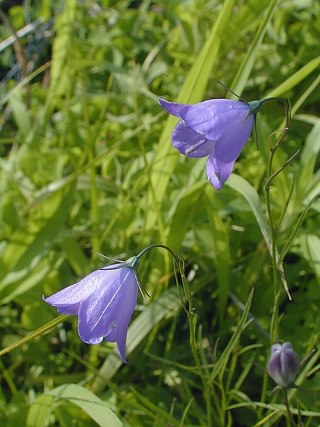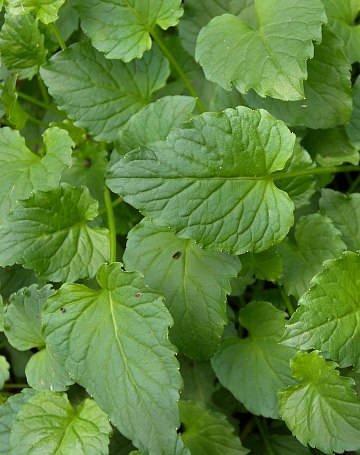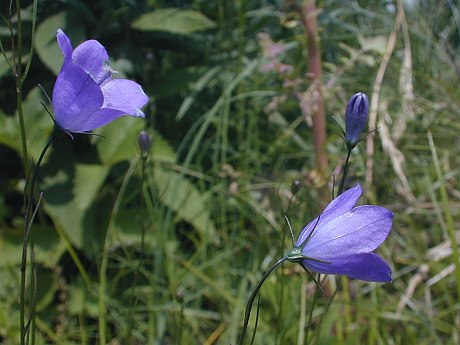Description: This perennial plant is about ½–1½' and unbranched, except for some upper side stems near the inflorescence. Often, several stems will emerge from the same rootstock; they remain reasonably erect. The basal leaves have long petioles, and are about 1" across. They are usually cordate or orbicular and their margins are bluntly dentate. The basal leaves often wither away by flowering time. Along the slender central stem are alternate leaves. These leaves are linear and about ½–2" long. They usually angle upward from the stem, and then curve outward. Usually the foliage and stems are without hairs, although sometimes they are slightly pubescent.

The central stem
(and some of the side stems) terminates in either a solitary flower, or
a short raceme of 2-3 flowers. These flowers are violet and
bell-shaped. A typical flower is about ¾" long, and tends to hang
toward from a slender pedicel. The corolla has 5 short lobes that curve
outward. The interior of a flower is white or pale violet near the
base, while a long violet style projects slightly beyond the outer rim
of the corolla. This style terminates into a tripartite white stigma.
The green calyx divides into 5 slender segments that are slightly
recurved. The blooming period occurs from early to late summer, and
lasts about 2-3 months. There is no noticeable floral scent. The
flowers are replaced by ovoid capsules that contain numerous tiny
seeds. These seeds are easily dispersed by gusts of wind. The root
system consists of a taproot.
Cultivation:
This little plant prefers full sunlight and moist to dry conditions. It
typically grows in shallow rocky soil, but will flourish in ordinary
garden soil if taller, more aggressive plants are kept away. Harebell
is surprisingly easy to grow, notwithstanding its delicate appearance.
It tolerates alkaline soil.

Range &
Habitat:
The native Harebell is an uncommon plant that occurs primarily in
northern
Illinois (see Distribution
Map). It is more common in areas to the north and east of
Illinois. Habitats include sandy Black Oak savannas, hill prairies,
crevices of sandstone, limestone, or dolomite cliffs, and shallow rocky
soil along streams. It also occurs along roadsides in neighboring
states. Generally, Harebell is found in high quality habitats where
there are rocky slopes. It also cultivated in gardens.
Faunal Associations:
Various bees
often visit the flowers, where they seek nectar. While the foliage is
potentially edible to mammalian herbivores, only the basal leaves are
sufficiently large to attract much attention from them. The seeds are
too small to
be of any interest to birds.

Photographic
Location:
The photographs of the flowers were taken at the webmaster's wildflower
garden in
Urbana, Illinois, while the photograph of the basal leaves was taken at
the Japan House of the University of Illinois in the same city.
Comments:
This is a charming little plant. Harebell is distributed in both the
Old World and New World, and may be variable across its large range.
The native Campanula aparinoides (Marsh Bellflower)
has smaller flowers and is found in wetland areas. Sometimes non-native
bellflowers escape into the wild, such as Campanula
rapunculoides (Creeping Bellflower), but they have broader
foliage and larger flowers.